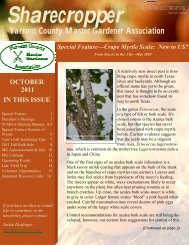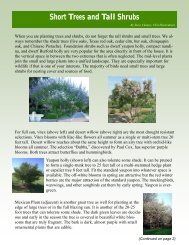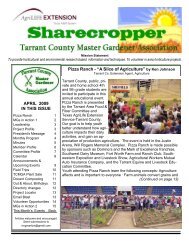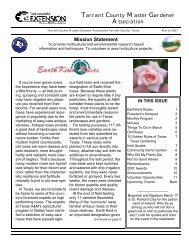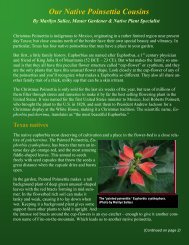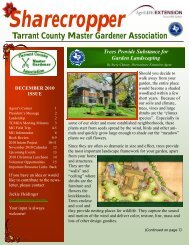thanks for a good year! - Tarrant County Master Gardener Association
thanks for a good year! - Tarrant County Master Gardener Association
thanks for a good year! - Tarrant County Master Gardener Association
Create successful ePaper yourself
Turn your PDF publications into a flip-book with our unique Google optimized e-Paper software.
#<br />
<br />
<br />
HOLLY SPECIMEN TREES<br />
by Derald Freeman<br />
sure you do not purchase a male plant, purchase<br />
hollies when there are berries on the plant.<br />
Have you tried it all Not quite!<br />
You have tried or considered Crape Myrtles,<br />
Brad<strong>for</strong>d pears, and other shrub-like trees <strong>for</strong> your<br />
landscape The only problem is they are beautiful<br />
in the summer all leafed out. But when fall comes<br />
and they drop all the foliage and look like<br />
scarecrows. Why not consider the Holly<br />
The Holly, Ilex sp. is from the Aquifoliacea<br />
family. The genus has over 400 species of<br />
evergreen and deciduous trees, shrubs, and<br />
climbers. There are about a dozen that are popular<br />
in Texas and all are evergreen with one exception,<br />
the Possumhaw Holly, which drops its leaves in the<br />
winter but puts on a dazzling show of red berries<br />
that look like a Christmas tree.<br />
Most hollies grow in zones 7-9, many as cold as<br />
zone 5. Hollies typically have three types of<br />
leaves. Normally leaves are thick and leathery.<br />
My favorite is the'Nellie R. Stevens'(Ilex cornuta<br />
‘Nellie R Stevens’). This tall beautiful holly is a<br />
vigorous, conical, evergreen female with sparsely<br />
spiny leaves and produces abundant scarlet fruit. It<br />
makes a splendid screen by a fence or as an accent<br />
next to the house. It is disease resistant, tough as<br />
nails, and requires little or no attention.<br />
The Ilex cornuta 'Needle Point'holly is a close<br />
cousin to NRS holly.<br />
The yaupon holly, Ilex vomitoria, is commonly<br />
grown as a trimmed hedge, tolerates a variety of<br />
soils, likes full sun to shade, and will thrive<br />
drought soil conditions. This one has small, thin,<br />
dark leaves, without the leather appearance of<br />
many other hollies.<br />
Bur<strong>for</strong>d holly, Ilex cornuta ‘Bur<strong>for</strong>d’ is an<br />
excellent evergreen choice <strong>for</strong> a tall shrub under<br />
windows or down the side of your house. Leaves<br />
have a single spine and produce red berries freely.<br />
To further add to your list of desirable hollies<br />
consider the following choices.<br />
'East Palatka'is a pyramidal female tree, 'Foster'<br />
has a rounded, pyramidal <strong>for</strong>m with orange-yellow<br />
berries, and of course the 'Mary Nell'that has a<br />
pyramidal <strong>for</strong>m, dark olive green leaves with short<br />
spines and vivid red berries.<br />
Some species have spiny leaves that are sharp like<br />
needles, so plant them away from a walk and just<br />
admire them.<br />
The beneficial characteristics of Hollies disease/<br />
insect resistance, tolerate most any type of soil,<br />
heat and cold tolerant, and keep putting on a show.<br />
Most of the hollies have beautiful red berries <strong>for</strong><br />
fruit/seed. Most hollies are dioecious with some<br />
plants only growing female or pistillate flowerets<br />
and some only grow male or staminate. To make<br />
Which is best <strong>for</strong> you Read about them and make<br />
your selection on height and width. The beauty of<br />
selecting hollies is, you just can't make a wrong<br />
decision.






